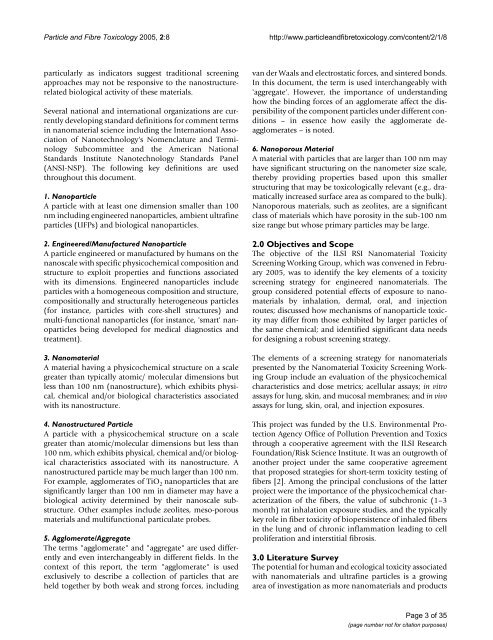Particle and Fibre Toxicology - Nanowerk
Particle and Fibre Toxicology - Nanowerk
Particle and Fibre Toxicology - Nanowerk
Create successful ePaper yourself
Turn your PDF publications into a flip-book with our unique Google optimized e-Paper software.
<strong>Particle</strong> <strong>and</strong> <strong>Fibre</strong> <strong>Toxicology</strong> 2005, 2:8<br />
http://www.particle<strong>and</strong>fibretoxicology.com/content/2/1/8<br />
particularly as indicators suggest traditional screening<br />
approaches may not be responsive to the nanostructurerelated<br />
biological activity of these materials.<br />
Several national <strong>and</strong> international organizations are currently<br />
developing st<strong>and</strong>ard definitions for comment terms<br />
in nanomaterial science including the International Association<br />
of Nanotechnology's Nomenclature <strong>and</strong> Terminology<br />
Subcommittee <strong>and</strong> the American National<br />
St<strong>and</strong>ards Institute Nanotechnology St<strong>and</strong>ards Panel<br />
(ANSI-NSP). The following key definitions are used<br />
throughout this document.<br />
1. Nanoparticle<br />
A particle with at least one dimension smaller than 100<br />
nm including engineered nanoparticles, ambient ultrafine<br />
particles (UFPs) <strong>and</strong> biological nanoparticles.<br />
2. Engineered/Manufactured Nanoparticle<br />
A particle engineered or manufactured by humans on the<br />
nanoscale with specific physicochemical composition <strong>and</strong><br />
structure to exploit properties <strong>and</strong> functions associated<br />
with its dimensions. Engineered nanoparticles include<br />
particles with a homogeneous composition <strong>and</strong> structure,<br />
compositionally <strong>and</strong> structurally heterogeneous particles<br />
(for instance, particles with core-shell structures) <strong>and</strong><br />
multi-functional nanoparticles (for instance, 'smart' nanoparticles<br />
being developed for medical diagnostics <strong>and</strong><br />
treatment).<br />
3. Nanomaterial<br />
A material having a physicochemical structure on a scale<br />
greater than typically atomic/ molecular dimensions but<br />
less than 100 nm (nanostructure), which exhibits physical,<br />
chemical <strong>and</strong>/or biological characteristics associated<br />
with its nanostructure.<br />
4. Nanostructured <strong>Particle</strong><br />
A particle with a physicochemical structure on a scale<br />
greater than atomic/molecular dimensions but less than<br />
100 nm, which exhibits physical, chemical <strong>and</strong>/or biological<br />
characteristics associated with its nanostructure. A<br />
nanostructured particle may be much larger than 100 nm.<br />
For example, agglomerates of TiO 2 nanoparticles that are<br />
significantly larger than 100 nm in diameter may have a<br />
biological activity determined by their nanoscale substructure.<br />
Other examples include zeolites, meso-porous<br />
materials <strong>and</strong> multifunctional particulate probes.<br />
5. Agglomerate/Aggregate<br />
The terms "agglomerate" <strong>and</strong> "aggregate" are used differently<br />
<strong>and</strong> even interchangeably in different fields. In the<br />
context of this report, the term "agglomerate" is used<br />
exclusively to describe a collection of particles that are<br />
held together by both weak <strong>and</strong> strong forces, including<br />
van der Waals <strong>and</strong> electrostatic forces, <strong>and</strong> sintered bonds.<br />
In this document, the term is used interchangeably with<br />
'aggregate'. However, the importance of underst<strong>and</strong>ing<br />
how the binding forces of an agglomerate affect the dispersibility<br />
of the component particles under different conditions<br />
– in essence how easily the agglomerate deagglomerates<br />
– is noted.<br />
6. Nanoporous Material<br />
A material with particles that are larger than 100 nm may<br />
have significant structuring on the nanometer size scale,<br />
thereby providing properties based upon this smaller<br />
structuring that may be toxicologically relevant (e.g., dramatically<br />
increased surface area as compared to the bulk).<br />
Nanoporous materials, such as zeolites, are a significant<br />
class of materials which have porosity in the sub-100 nm<br />
size range but whose primary particles may be large.<br />
2.0 Objectives <strong>and</strong> Scope<br />
The objective of the ILSI RSI Nanomaterial Toxicity<br />
Screening Working Group, which was convened in February<br />
2005, was to identify the key elements of a toxicity<br />
screening strategy for engineered nanomaterials. The<br />
group considered potential effects of exposure to nanomaterials<br />
by inhalation, dermal, oral, <strong>and</strong> injection<br />
routes; discussed how mechanisms of nanoparticle toxicity<br />
may differ from those exhibited by larger particles of<br />
the same chemical; <strong>and</strong> identified significant data needs<br />
for designing a robust screening strategy.<br />
The elements of a screening strategy for nanomaterials<br />
presented by the Nanomaterial Toxicity Screening Working<br />
Group include an evaluation of the physicochemical<br />
characteristics <strong>and</strong> dose metrics; acellular assays; in vitro<br />
assays for lung, skin, <strong>and</strong> mucosal membranes; <strong>and</strong> in vivo<br />
assays for lung, skin, oral, <strong>and</strong> injection exposures.<br />
This project was funded by the U.S. Environmental Protection<br />
Agency Office of Pollution Prevention <strong>and</strong> Toxics<br />
through a cooperative agreement with the ILSI Research<br />
Foundation/Risk Science Institute. It was an outgrowth of<br />
another project under the same cooperative agreement<br />
that proposed strategies for short-term toxicity testing of<br />
fibers [2]. Among the principal conclusions of the latter<br />
project were the importance of the physicochemical characterization<br />
of the fibers, the value of subchronic (1–3<br />
month) rat inhalation exposure studies, <strong>and</strong> the typically<br />
key role in fiber toxicity of biopersistence of inhaled fibers<br />
in the lung <strong>and</strong> of chronic inflammation leading to cell<br />
proliferation <strong>and</strong> interstitial fibrosis.<br />
3.0 Literature Survey<br />
The potential for human <strong>and</strong> ecological toxicity associated<br />
with nanomaterials <strong>and</strong> ultrafine particles is a growing<br />
area of investigation as more nanomaterials <strong>and</strong> products<br />
Page 3 of 35<br />
(page number not for citation purposes)
















